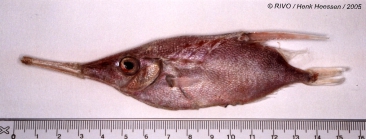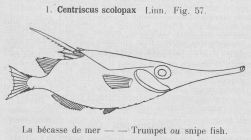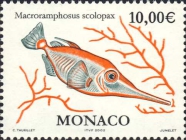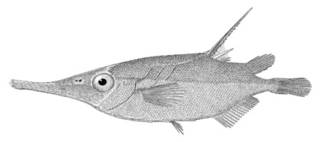WoRMS taxon details
Macroramphosus scolopax (Linnaeus, 1758)
127378 (urn:lsid:marinespecies.org:taxname:127378)
accepted
Species
Balistes scolopax Linnaeus, 1758 · unaccepted (synonym)
Centriscus scolopax (Linnaeus, 1758) · unaccepted (synonym)
Centriscus squamosus Bloch, 1785 · unaccepted
Macrorhamphosus scolopax (Linnaeus, 1758) · unaccepted (misspelling)
Silurus cornutus Forsskål, 1775 · unaccepted (synonym)
Solenostomus scolopax (Linnaeus, 1758) · unaccepted
marine, brackish, fresh, terrestrial
(of Centriscus scolopax (Linnaeus, 1758)) Linnaeus, C. (1758). Systema Naturae per regna tria naturae, secundum classes, ordines, genera, species, cum characteribus, differentiis, synonymis, locis. <em>Editio decima, reformata [10th revised edition], vol. 1: 824 pp. Laurentius Salvius: Holmiae.</em> , available online at https://biodiversitylibrary.org/page/726886 [details] Available for editors  [request]
[request]
(of Balistes scolopax Linnaeus, 1758) Linnaeus, C. (1758). Systema Naturae per regna tria naturae, secundum classes, ordines, genera, species, cum characteribus, differentiis, synonymis, locis. <em>Editio decima, reformata [10th revised edition], vol. 1: 824 pp. Laurentius Salvius: Holmiae.</em> , available online at https://biodiversitylibrary.org/page/726886 [details] Available for editors [request]
[request]
(of Balistes scolopax Linnaeus, 1758) Linnaeus, C. (1758). Systema Naturae per regna tria naturae, secundum classes, ordines, genera, species, cum characteribus, differentiis, synonymis, locis. <em>Editio decima, reformata [10th revised edition], vol. 1: 824 pp. Laurentius Salvius: Holmiae.</em> , available online at https://biodiversitylibrary.org/page/726886 [details] Available for editors
Description Found between the seabed and midwater on the lower continental shelf, over sand. Juveniles found in oceanic surface waters...
Distribution Western Atlantic: 42.96°N and the Greater Antilles; also northern South America and Argentina
Description Found between the seabed and midwater on the lower continental shelf, over sand. Juveniles found in oceanic surface waters (Ref. 2683); adults normally live close to the bottom (normally in 50-150 m depth). Gregarious. Juveniles feed mainly on pelagic invertebrates, mainly copepods, while adults feed on bottom invertebrates (Ref. 6732). [details]
Distribution Western Atlantic: 42.96°N and the Greater Antilles; also northern South America and Argentina
Distribution Western Atlantic: 42.96°N and the Greater Antilles; also northern South America and Argentina [details]
Froese, R. and D. Pauly. Editors. (2024). FishBase. Macroramphosus scolopax (Linnaeus, 1758). Accessed through: World Register of Marine Species at: https://www.marinespecies.org/aphia.php?p=taxdetails&id=127378 on 2024-09-20
Date
action
by
![]() The webpage text is licensed under a Creative Commons Attribution-Noncommercial 4.0 License
The webpage text is licensed under a Creative Commons Attribution-Noncommercial 4.0 License
original description
(of Centriscus scolopax (Linnaeus, 1758)) Linnaeus, C. (1758). Systema Naturae per regna tria naturae, secundum classes, ordines, genera, species, cum characteribus, differentiis, synonymis, locis. <em>Editio decima, reformata [10th revised edition], vol. 1: 824 pp. Laurentius Salvius: Holmiae.</em> , available online at https://biodiversitylibrary.org/page/726886 [details] Available for editors  [request]
[request]
original description (of Balistes scolopax Linnaeus, 1758) Linnaeus, C. (1758). Systema Naturae per regna tria naturae, secundum classes, ordines, genera, species, cum characteribus, differentiis, synonymis, locis. <em>Editio decima, reformata [10th revised edition], vol. 1: 824 pp. Laurentius Salvius: Holmiae.</em> , available online at https://biodiversitylibrary.org/page/726886 [details] Available for editors [request]
[request]
original description (of Silurus cornutus Forsskål, 1775) Forskål P. (1775). Descriptiones Animalium, Avium, Amphibiorum, Piscium, Insectorum, Vermium; quae in Itinere Orientali Observavit Petrus Forskål. Post Mortem Auctoris editit Carsten Niebuhr. Adjuncta est materia Medica Kahirina. Mölleri, Hafniae, 19 + xxxiv + 164 pp. , available online at https://www.biodiversitylibrary.org/page/2088059 [details]
context source (Deepsea) Intergovernmental Oceanographic Commission (IOC) of UNESCO. The Ocean Biogeographic Information System (OBIS), available online at http://www.iobis.org/ [details]
context source (Bermuda) Smith-Vaniz, W. F.; Collette, B. B.; Luckhurst, B. E (1999). Fishes of Bermuda: History, zoogeography, annotated checklist, and identification keys (American Society of Ichthyologists and Herpetologists - Special Publication No.4) . ASIH, 424 pp. [details]
basis of record van der Land, J.; Costello, M.J.; Zavodnik, D.; Santos, R.S.; Porteiro, F.M.; Bailly, N.; Eschmeyer, W.N.; Froese, R. (2001). Pisces, <B><I>in</I></B>: Costello, M.J. <i>et al.</i> (Ed.) (2001). <i>European register of marine species: a check-list of the marine species in Europe and a bibliography of guides to their identification. Collection Patrimoines Naturels,</i> 50: pp. 357-374 (look up in IMIS) [details]
additional source Gulf of Maine Biogeographic Information System (GMBIS) Electronic Atlas. 2002. November, 2002. [details]
additional source Welshman, D.; Kohler, S; Black, J.; and L. Van Guelpen. (2003). An atlas of distributions of Canadian Atlantic fishes. , available online at http://epe.lac-bac.gc.ca/100/205/301/ic/cdc/FishAtlas/default.htm [details]
additional source King, C.M.; Roberts, C.D.; Bell, B.D.; Fordyce, R.E.; Nicoll, R.S.; Worthy, T.H.; Paulin, C.D.; Hitchmough, R.A.; Keyes, I.W.; Baker, A.N.; Stewart, A.L.; Hiller, N.; McDowall, R.M.; Holdaway, R.N.; McPhee, R.P.; Schwarzhans, W.W.; Tennyson, A.J.D.; Rust, S.; Macadie, I. (2009). Phylum Chordata: lancelets, fishes, amphibians, reptiles, birds, mammals. <em>in: Gordon, D.P. (Ed.) (2009). New Zealand inventory of biodiversity: 1. Kingdom Animalia: Radiata, Lophotrochozoa, Deuterostomia.</em> pp. 431-554. [details]
additional source McEachran, J. D. (2009). Fishes (Vertebrata: Pisces) of the Gulf of Mexico, Pp. 1223–1316 in: Felder, D.L. and D.K. Camp (eds.), Gulf of Mexico–Origins, Waters, and Biota. Biodiversity. Texas A&M Press, College Station, Texas. [details]
additional source Linnaeus, C. (1758). Systema Naturae per regna tria naturae, secundum classes, ordines, genera, species, cum characteribus, differentiis, synonymis, locis. <em>Editio decima, reformata [10th revised edition], vol. 1: 824 pp. Laurentius Salvius: Holmiae.</em> , available online at https://biodiversitylibrary.org/page/726886
page(s): 329 [details] Available for editors [request]
[request]
additional source Fricke, R., Eschmeyer, W. N. & Van der Laan, R. (eds). (2024). ECoF. Eschmeyer's Catalog of Fishes: Genera, Species, References. <em>California Academy of Sciences. San Francisco.</em> Electronic version accessed dd mmm 2024., available online at http://researcharchive.calacademy.org/research/Ichthyology/catalog/fishcatmain.asp [details]
additional source Froese, R. & D. Pauly (Editors). (2023). FishBase. World Wide Web electronic publication. version (02/2023)., available online at https://www.fishbase.org [details]
ecology source Looby, A.; Erbe, C.; Bravo, S.; Cox, K.; Davies, H. L.; Di Iorio, L.; Jézéquel, Y.; Juanes, F.; Martin, C. W.; Mooney, T. A.; Radford, C.; Reynolds, L. K.; Rice, A. N.; Riera, A.; Rountree, R.; Spriel, B.; Stanley, J.; Vela, S.; Parsons, M. J. G. (2023). Global inventory of species categorized by known underwater sonifery. <em>Scientific Data.</em> 10(1). (look up in IMIS), available online at https://doi.org/10.1038/s41597-023-02745-4 [details]
original description (of Balistes scolopax Linnaeus, 1758) Linnaeus, C. (1758). Systema Naturae per regna tria naturae, secundum classes, ordines, genera, species, cum characteribus, differentiis, synonymis, locis. <em>Editio decima, reformata [10th revised edition], vol. 1: 824 pp. Laurentius Salvius: Holmiae.</em> , available online at https://biodiversitylibrary.org/page/726886 [details] Available for editors
original description (of Silurus cornutus Forsskål, 1775) Forskål P. (1775). Descriptiones Animalium, Avium, Amphibiorum, Piscium, Insectorum, Vermium; quae in Itinere Orientali Observavit Petrus Forskål. Post Mortem Auctoris editit Carsten Niebuhr. Adjuncta est materia Medica Kahirina. Mölleri, Hafniae, 19 + xxxiv + 164 pp. , available online at https://www.biodiversitylibrary.org/page/2088059 [details]
context source (Deepsea) Intergovernmental Oceanographic Commission (IOC) of UNESCO. The Ocean Biogeographic Information System (OBIS), available online at http://www.iobis.org/ [details]
context source (Bermuda) Smith-Vaniz, W. F.; Collette, B. B.; Luckhurst, B. E (1999). Fishes of Bermuda: History, zoogeography, annotated checklist, and identification keys (American Society of Ichthyologists and Herpetologists - Special Publication No.4) . ASIH, 424 pp. [details]
basis of record van der Land, J.; Costello, M.J.; Zavodnik, D.; Santos, R.S.; Porteiro, F.M.; Bailly, N.; Eschmeyer, W.N.; Froese, R. (2001). Pisces, <B><I>in</I></B>: Costello, M.J. <i>et al.</i> (Ed.) (2001). <i>European register of marine species: a check-list of the marine species in Europe and a bibliography of guides to their identification. Collection Patrimoines Naturels,</i> 50: pp. 357-374 (look up in IMIS) [details]
additional source Gulf of Maine Biogeographic Information System (GMBIS) Electronic Atlas. 2002. November, 2002. [details]
additional source Welshman, D.; Kohler, S; Black, J.; and L. Van Guelpen. (2003). An atlas of distributions of Canadian Atlantic fishes. , available online at http://epe.lac-bac.gc.ca/100/205/301/ic/cdc/FishAtlas/default.htm [details]
additional source King, C.M.; Roberts, C.D.; Bell, B.D.; Fordyce, R.E.; Nicoll, R.S.; Worthy, T.H.; Paulin, C.D.; Hitchmough, R.A.; Keyes, I.W.; Baker, A.N.; Stewart, A.L.; Hiller, N.; McDowall, R.M.; Holdaway, R.N.; McPhee, R.P.; Schwarzhans, W.W.; Tennyson, A.J.D.; Rust, S.; Macadie, I. (2009). Phylum Chordata: lancelets, fishes, amphibians, reptiles, birds, mammals. <em>in: Gordon, D.P. (Ed.) (2009). New Zealand inventory of biodiversity: 1. Kingdom Animalia: Radiata, Lophotrochozoa, Deuterostomia.</em> pp. 431-554. [details]
additional source McEachran, J. D. (2009). Fishes (Vertebrata: Pisces) of the Gulf of Mexico, Pp. 1223–1316 in: Felder, D.L. and D.K. Camp (eds.), Gulf of Mexico–Origins, Waters, and Biota. Biodiversity. Texas A&M Press, College Station, Texas. [details]
additional source Linnaeus, C. (1758). Systema Naturae per regna tria naturae, secundum classes, ordines, genera, species, cum characteribus, differentiis, synonymis, locis. <em>Editio decima, reformata [10th revised edition], vol. 1: 824 pp. Laurentius Salvius: Holmiae.</em> , available online at https://biodiversitylibrary.org/page/726886
page(s): 329 [details] Available for editors
additional source Fricke, R., Eschmeyer, W. N. & Van der Laan, R. (eds). (2024). ECoF. Eschmeyer's Catalog of Fishes: Genera, Species, References. <em>California Academy of Sciences. San Francisco.</em> Electronic version accessed dd mmm 2024., available online at http://researcharchive.calacademy.org/research/Ichthyology/catalog/fishcatmain.asp [details]
additional source Froese, R. & D. Pauly (Editors). (2023). FishBase. World Wide Web electronic publication. version (02/2023)., available online at https://www.fishbase.org [details]
ecology source Looby, A.; Erbe, C.; Bravo, S.; Cox, K.; Davies, H. L.; Di Iorio, L.; Jézéquel, Y.; Juanes, F.; Martin, C. W.; Mooney, T. A.; Radford, C.; Reynolds, L. K.; Rice, A. N.; Riera, A.; Rountree, R.; Spriel, B.; Stanley, J.; Vela, S.; Parsons, M. J. G. (2023). Global inventory of species categorized by known underwater sonifery. <em>Scientific Data.</em> 10(1). (look up in IMIS), available online at https://doi.org/10.1038/s41597-023-02745-4 [details]
 Present
Present  Present in aphia/obis/gbif/idigbio
Present in aphia/obis/gbif/idigbio  Inaccurate
Inaccurate  Introduced: alien
Introduced: alien  Containing type locality
Containing type locality
From other sources
Description Found between the seabed and midwater on the lower continental shelf, over sand. Juveniles found in oceanic surface waters (Ref. 2683); adults normally live close to the bottom (normally in 50-150 m depth). Gregarious. Juveniles feed mainly on pelagic invertebrates, mainly copepods, while adults feed on bottom invertebrates (Ref. 6732). [details]Diet Juveniles feed mainly on copepods and adults prefer bottom invertebrates [details]
Distribution Western Atlantic: 42.96°N and the Greater Antilles; also northern South America and Argentina [details]
Habitat benthic [details]
Habitat Known from seamounts and knolls [details]
Habitat Found between the seabed and midwater on the lower continental shelf, over sand. [details]
Importance Social- Commercial, fishery [details]
Reproduction External fertilization.Spawns in January and February off the Canary Islands [details]
| Language | Name | |
|---|---|---|
| Albanian | peshku trompetë | [details] |
| Danish | sneppefisk [from synonym] | [details] |
| Dutch | snipvis | [details] |
| English | snipe-fishsnipefishlongspine spinefishLongspine snipefish [from synonym]longspine snipefish | [details] |
| French | bécasse de mer | [details] |
| German | Schnepenfisch | [details] |
| Hebrew | חרטומן-ים מצוי [from synonym] | [details] |
| Japanese | サギフエ | [details] |
| Modern Greek (1453-) | Μπεκατσόψαρο | [details] |
| Norwegian Bokmål | trompetfisk | [details] |
| Norwegian Nynorsk | trompetfisk | [details] |
| Russian | Морской бекас [from synonym] | [details] |
| Spanish | trompetero copete | [details] |
| Swedish | snäppfisk | [details] |
| Turkish | boru baligi | [details] |
To Barcode of Life (116 barcodes)
To Biodiversity Heritage Library (12 publications) (from synonym Solenostomus scolopax (Linnaeus, 1758))
To Biodiversity Heritage Library (13 publications) (from synonym Balistes scolopax Linnaeus, 1758)
To Biodiversity Heritage Library (14 publications) (from synonym Silurus cornutus Forsskål, 1775)
To Biodiversity Heritage Library (253 publications) (from synonym Centriscus scolopax (Linnaeus, 1758))
To Biodiversity Heritage Library (3 publications)
To Biodiversity Heritage Library (6 publications) (from synonym Centriscus squamosus Bloch, 1785)
To Biodiversity Heritage Library (62 publications) (from synonym Macrorhamphosus scolopax (Linnaeus, 1758))
To Biological Information System for Marine Life (BISMaL) (from synonym Macrorhamphosus scolopax (Linnaeus, 1758))
To Biological Information System for Marine Life (BISMaL)
To Dyntaxa
To European Nucleotide Archive, ENA (Macroramphosus scolopax)
To FishBase (from synonym Balistes scolopax Linnaeus, 1758)
To FishBase
To FishBase (from synonym Centriscus squamosus Bloch, 1785)
To FishBase (from synonym Solenostomus scolopax (Linnaeus, 1758))
To FishBase (from synonym Macrorhamphosus scolopax (Linnaeus, 1758))
To FishBase (from synonym Centriscus scolopax (Linnaeus, 1758))
To FishBase (from synonym Silurus cornutus Forsskål, 1775)
To FishBase images (Macroramphosus scolopax, Canary Is., by Hernández-González, C.L.)
To Fishipedia
To GenBank (20877 nucleotides; 147 proteins)
To GenBank (20877 nucleotides; 147 proteins) (from synonym Balistes scolopax Linnaeus, 1758)
To Global Biotic Interactions (GloBI)
To IUCN Red List (Least Concern)
To NMNH Extant Collection (Centriscus scolopax P02415 illustration)
To NMNH Extant Collection (Macroramphosus scolopax RAD107339-001)
To PESI
To PESI (from synonym Macrorhamphosus scolopax (Linnaeus, 1758))
To ITIS
To Biodiversity Heritage Library (12 publications) (from synonym Solenostomus scolopax (Linnaeus, 1758))
To Biodiversity Heritage Library (13 publications) (from synonym Balistes scolopax Linnaeus, 1758)
To Biodiversity Heritage Library (14 publications) (from synonym Silurus cornutus Forsskål, 1775)
To Biodiversity Heritage Library (253 publications) (from synonym Centriscus scolopax (Linnaeus, 1758))
To Biodiversity Heritage Library (3 publications)
To Biodiversity Heritage Library (6 publications) (from synonym Centriscus squamosus Bloch, 1785)
To Biodiversity Heritage Library (62 publications) (from synonym Macrorhamphosus scolopax (Linnaeus, 1758))
To Biological Information System for Marine Life (BISMaL) (from synonym Macrorhamphosus scolopax (Linnaeus, 1758))
To Biological Information System for Marine Life (BISMaL)
To Dyntaxa
To European Nucleotide Archive, ENA (Macroramphosus scolopax)
To FishBase (from synonym Balistes scolopax Linnaeus, 1758)
To FishBase
To FishBase (from synonym Centriscus squamosus Bloch, 1785)
To FishBase (from synonym Solenostomus scolopax (Linnaeus, 1758))
To FishBase (from synonym Macrorhamphosus scolopax (Linnaeus, 1758))
To FishBase (from synonym Centriscus scolopax (Linnaeus, 1758))
To FishBase (from synonym Silurus cornutus Forsskål, 1775)
To FishBase images (Macroramphosus scolopax, Canary Is., by Hernández-González, C.L.)
To Fishipedia
To GenBank (20877 nucleotides; 147 proteins)
To GenBank (20877 nucleotides; 147 proteins) (from synonym Balistes scolopax Linnaeus, 1758)
To Global Biotic Interactions (GloBI)
To IUCN Red List (Least Concern)
To NMNH Extant Collection (Centriscus scolopax P02415 illustration)
To NMNH Extant Collection (Macroramphosus scolopax RAD107339-001)
To PESI
To PESI (from synonym Macrorhamphosus scolopax (Linnaeus, 1758))
To ITIS














